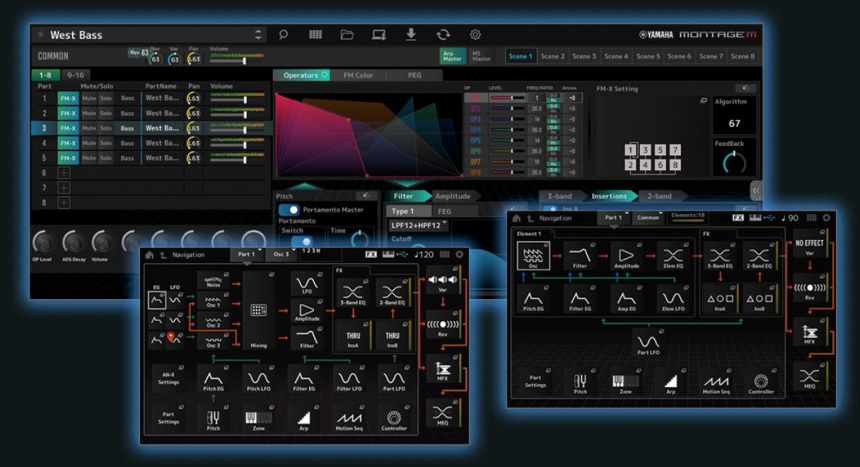Yamaha rarely invent a new technology and not reuse the same tech in a different product line. So it goes with the key sensor tech in Yamaha Montage M8x.
We all got an important clue from the most recent Music Production Guide:
The model MONTAGE M8x features a newly developed, special keyboard called “GEX”, which supports Polyphonic Aftertouch. Unlike other keyboards, the GEX keyboard does not use conventional key contacts, but electromagnetic induction. With this technology, each individual key position can be continuously scanned. In addition, the keyboard supports software updates, which enables the future development of further techniques and articulations beyond Polyphonic Aftertouch.
GEX has its origins in the latest Yamaha hybrid and Silent Piano product lines. This might explain why Yamaha brought out Polyphonic Aftertouch (PAT) in the 88-key version of the Montage M series and not M6/M7 Quite simply, Yamaha could use components and a keybed that were already sitting on its shelf.
This blog post is a bit of a clip-show. I’m collecting information about the sensor technology and want to share a few starting points for further reading and exploration.
Three types of key sensors
Yamaha have three major key sensor technologies in use today:
- 2- and 3-contact rubber key strips — the most-widely used type,
- Non-contact 2-point optical fiber hammer/key sensors — employed in hybrid, Silent Piano™ and Transacoustic™ pianos, and
- Non-contact continuous detection electromagnetic induction sensor — the latest tech.
I won’t be saying much about the rubber key strips because this technology is so well-known.
Electromagnetic induction key sensors
Yamaha announced its new line-up of TransAcoustic and Silent Piano models in August 2022. As part of the announcement, Yamaha briefly described a newly developed “Articulation Sensor System.”
We have newly developed an electronic “Articulation Sensor System”. Wireless communication from sensors installed under all 88 keys allows for natural playing without sacrificing the piano’s original touch. In addition, it is now possible to always accurately grasp the movement of keys being pressed and released, and to detect minute movements of the keyboard, such as when playing staccato, more accurately than before.
Specifications for the SH3 and SC3 Silent Pianos identify the key sensing system as “Non-contact continuous detection electromagnetic induction sensor.”
The new Yamaha Montage M8x employs the latest electromagnetic induction key sensing technology in its GEX keyboard.
Previously, Transacoustic and Silent Pianos employed contactless, optical hammer and key detection. As you can see from its description below, the optical key sensors require much labor and costly components. The gradient optical key shutters must be carefully aligned.
The new electromagnetic induction key sensors appear to be easier to build and install. Each key has small inductive loop on the bottom. Sensors on the printed circuit board below the keys detect loop (key) movements.
Because the electromagnetic induction sensors are so new, it will be some time before we learn the details about the new sensor technology.
NU1XA AvantGrand
When I heard “electromagnetic induction” and “hybrid” fall out of Blake’s mouth, I instantly remembered the Yamaha NU1XA hybrid piano. The NU1XA combines an upright’s key action with digital synthesis. The Yamaha Articulation Sensor System is described in the following way:
The NU1XA features our newly developed Articulation Sensor System, which accurately and continuously captures the pianist’s subtlest performance nuances, through non-contact electromagnetic sensors and Yamaha’s proprietary algorithm. This system utilizes two separate sensors on each key: one for the hammer — the most crucial part of the acoustic piano sound mechanism — and the other for the key itself, to precisely measure the movement of finger release and articulate exactly the special nuances when the sound stops. Together, they fully capture the most delicate expressions of the player. [Yamaha]
Obviously, the Montage M8x does not have hammers and Montage M8x has only under-key sensors. [Needs to be verified.]
Yamaha have been working to simulate the interplay between a pianists fingers (and pedals) in order to “craft changes in timbre according to the speed and depth with which the keys are pressed.” Yamaha calls these proprietary algorithms and software “Grand Expression Modeling.” Like Montage M PAT, the Yamaha secret sauce is in the software.
This technology goes well-beyond simple 2- and 3-switch discrete sensing into the realm of continuous sensing. You’ll find 2-switch sensing in most other Yamaha synths and arrangers. 3-switch switch sensing is found in so-called “triple sensor” keybeds like GH3, GH3X and NWX.
Optical shutter key sensors
Under each of the 88 keys is a Yamaha-unique continuous-detection grey-scale shutter key sensor. These sensors detect the movement of the keys continually, allowing natural musical expression even when the piano is in SILENT Piano™ function. Since they do not come into contact with the keys, these sensors do not affect the feel of the keyboard in any way. [Yamaha]
I’m sure all of this Yamaha tech is patented. Happy hunting at the USPTO!
[Update: Thanks to Jason at the Yamaha Synth Forum who found these two Yamaha patents: U.S. Patent 5612502A and 6121535.]
Silent Piano optical sensors
The old Yamaha Silent Piano™ line use continuous key and damper pedal detection. Key sensing uses optical shutters.
Yamaha Silent Pianos go one step further than the hybrids — Silent Pianos are complete pianos with action, strings and soundboard. When a Silent Piano is switched to Quiet Mode, the hammers are stopped before hitting the strings. The articulation sensor system tracks key movement, sending data to Grand Expression Modeling and tone synthesis. [The Quiet and Acoustic Modes are selected with a silencing lever or pedal.]
If you use information from this article, please post a link to my site. Thanks!
Copyright © 2023 Paul J. Drongowski















